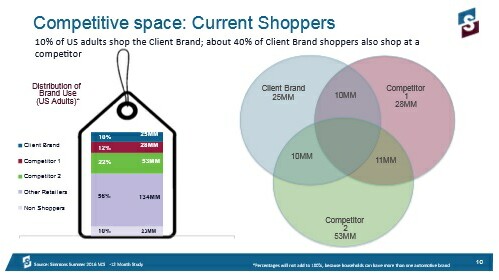Combining the Power of the Creative with the Power of Targeting

The creative is known to be the most powerful part of big brand advertising (65% of the ROI) -- whereas Direct Response finds that the offer and the target both outrank the creative. That makes sense in that the "offer" equates to the price, and marketing mix modeling shows that price/promotion outweighs advertising effects.
In my previous column about this, I was critical of how much is spent on promotion relative to advertising, and it's worth a postscript here to suggest a way that promotion can be profitable more than 20% of the time (as established by hundreds of IRI Behaviorscan studies).
An alternative to promotion in its current form would be more targeted promotion, similar to a free sample but covering the costs, and sent only to people for whom there is evidence that they have never tried your brand and they would probably like it a lot better than what they are currently buying. The evidence might be that their motivations in life and their motivations in buying the category point in the direction of the kind of satisfactions you feel your brand delivers.
Motivations are the hook which enables the power of the creative to be combined with the power of targeting. The highest ROIs will be achieved when targeting considers the motivations contained in the creative, as well as the past purchasing pattern establishing which people are most likely to sales respond to the ad because they are already leaning in a bit to the brand but are not yet loyal to it.
For example, if you feel that you have the jammiest red wine in the world, and you have eCom or frequent shopper card data from which you can identify people who buy jammy red wines, that's an example of targeting based on motivation -- in this case, product motivations.
MRI and Simmons have hundreds of product motivation questions in their database. BRI started that. Timothy Joyce and I introduced life motivations -- motivations that are not specific to a product category -- in TGI, Timothy's platform before he launched MRI.
There is of course a relationship between life motivations and product motivations. If for example you are highly motivated by a need to feel secure and safe, then the appeal of cars that win endorsements for their safety record are for you; if you seek sex you will want your toothpaste to do a good job on whitening and breath freshening; and so on.
A few years ago when I was consulting for Simmons and Steven Millman was the Chief Scientist there, and Pat Pellegrini the President, we devised a means of using all the Simmons product motivation data plus RMT DriverTags as a means of determining life motivations, to help a brand determine its creative strategy and brief to the creative agency. (You'll recall that RMT is a company I co-founded with Bill McKenna.)
Our work on the creative strategy began with an analysis of Simmons (with DriverTags added at the respondent level) to determine the overlap between a brand's customers and its competitors' customers. From this the strategy decision was which competitors to take customers away from, and then focused in on the life and product motivations of the customers shared with the targeted competitors. The advertising executions would bring out those motivations as new attributes to be identified with the client's brand, or as existing attributes to refresh and remind. This was the type of visual we used to plan such a strategy:

We assume going forward that every advertiser will be allocating some budget to content targeting and some percentage to ID-based targeting. After the executions are made based on the foregoing logic, their placement in media can reflect the overlaps between product motivation and life motivation segments with specific television programs, websites and IDs. MRI/Simmons has information like this on relatively small numbers of programs and sites, and demo lookalikes of such people on IDs at scale. RMT and partner Semasio have deterministic life motivations on IDs and websites at scale, and RMT has life motivations on thousands of TV programs, networks and daypart rotations. So today, motivations can definitely be targeted both ways, ID and content. As compared to demo targeting, a study presented at the ARF September conference showed that life plus product motivation targeting quintupled the drive to website for an advertised book. An Audi study recently proved that semantic lookalikes work far better than demographics if lookalikes must be used.
As contexts come back into heavier usage as targeting tools, it will also be useful to maximize ROI by ensuring that there is high motivational resonance between every ad and every context in which it's placed, as enabled by companies such as RMT.
Erwin Ephron loved the terms Propensity, Proclivity and Propinquity. He applied them to targeting by saying that targets should be people who show all three:
- Propensity: How much do they spend on the product category?
- Proclivity: Do they show signs of leaning into the brand (but are not yet loyal)?
- Propinquity: Will they be in the shopping window at a specific predictable time?
Nielsen NCS and Joel Rubinson did a study using past purchasing and shopping behavior to predict propinquity, which achieved major lifts in ROI.
To summarize the takeaways of the two articles concluded here:
- Use motivations and competitive overlap to help determine creative strategy.
- Use motivations, movable middle and predicted shopping trips to target and time activation to specific segments.
- Make sure that the motivations in the ad are congruent not only with the people you send the ad to, but that the motivations in the contexts also resonate with the ad's motivations, as this has been proven to increase both sales effect and branding effects.
This admittedly is a tall order and does not mirror the "stuck process" by which most media are bought and sold today, which is amazingly similar to the way it was being done when I entered the business.
If the CMO was held in higher regard within most corporations, would that lead to better marketing effectiveness methods being easier to introduce? As an industry we know much more about how it should be done than actually gets widely used, and we have been tied down like Gulliver for half a century, continuing to overspend on low CPMs disregarding quality factors, and on promotion.
When the rare brand experiments with doing it the right way, leveraging all that is known today to marketing science, the results are always spectacular.
If you missed it, go here to read my prior post on these same subjects.
Click the social buttons to share this content with your friends and colleagues.
The opinions and points of view expressed in this content are exclusively the views of the author and/or subject(s) and do not necessarily represent the views of MediaVillage.com/MyersBizNet, Inc. management or associated writers.


